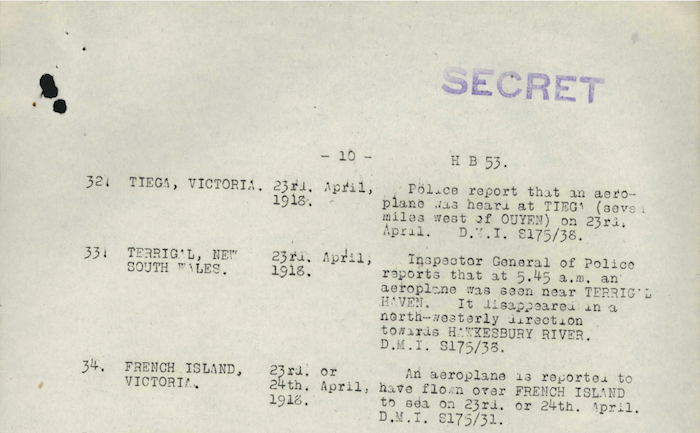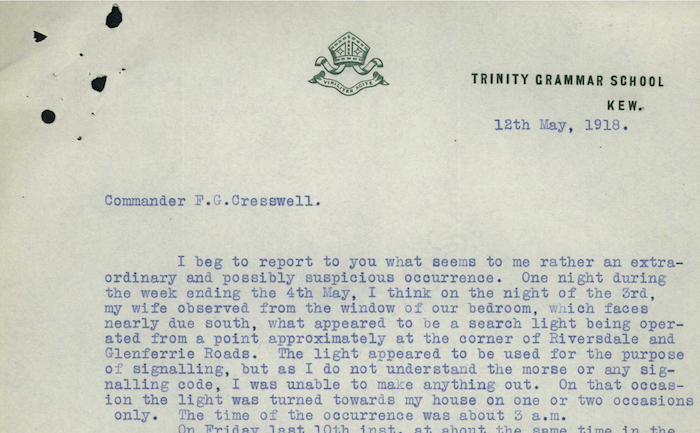
NAA: MP1049/1, 1918/066, pages 701 to 709 is a copy of Directorate of Military Intelligence report HB53, 'Aircraft, lights and objects reported seen in the air'. Copies have been sent to various District Naval Officers and the commanders of HMA Ships Brisbane, Encounter and Protector (presumably DMI sent it to the various military district HQs, as well). It consists of two parts. The first is 'a brief diary' of reports received of 'objects seen in the air', between 1 March and 27 April 1918, excluding 'Reports proved to be false'. This is a list of 41 separate mystery aeroplane reports, including place, date, and a summary (and file reference), beginning with Nubeena, Tasmania:
On the night of the 6th/7th of March and on eight successive nights, searchlights and moving lights in the sky were reported by Mr George E. Clarke of NUBEENA.
and ending with Grafton, New South Wales:
Police at GRAFTON report:- 'Informed on good authority that an aeroplane, the body painted white and the planes black, was seen at GRAFTON on 26th instant flying in a north-easterly direction.
A number of the sightings previously discussed appear here: Nyang (no. 4), Terrigal (no. 5), Macarthur (no. 7), Maffra (no. 11), Toora (no. 15), Bunbury (no. 17), Cape Leeuwin (no. 18), Christmas Hills (no. 19) and Ballarat West (no. 23). The last of these took place on 20 April, so the remaining 18 reports date from the last week, demonstrating how fast the mystery aeroplanes are multiplying. (Since the sightings are listed according to when they took place, not when they were reported -- which is why Nyang is at no. 4 -- this will actually be an understatement.)
The second part of HB53 is an analysis of the reports taken as a whole. This is done under several headings.
First, 'General distribution'. Excluding the reports from Tasmania and WA, the rest all come from 'between PORT LINCOLN, SOUTH AUSTRALIA, and GRAFTON, NEW SOUTH WALES', a distance of '1100 miles apart by direct air line' or '1500 miles by shortest sea line'.
Second, 'Nearness to the coast'. All of the sightings were made 'from localities within an hour's flight of the Coast', apart from the cluster in the Mallee, north-western Victoria (including Nyang).
Third, 'Nearness to settlements of enemy descent'. The patterns here are less clear-cut, but 'Some' of the sightings come from areas 'largely settled by persons of enemy descent' (the Mallee; Kapunda, South Australia) or at least 'near to such settlements' (Macarthur; Port Lincoln). In other cases 'there are known to be such persons, or persons otherwise suspect of employment by the enemy'. On the other hand, there are no reports 'from such German centres as the eastern RIVERINA or southern QUEENSLAND'.
Fourth, 'Occurrance [sic] in daylight or darkness'. Three out of every four sightings took place 'at dusk, during the night, or about dawn'.
Fifth, 'Minimum number of bases'.
Accepting all the reports as correct, and assuming that some or all of the aircraft are from vessels at sea, there must be at least four such vessels.
Looking at the time and place of the reported aeroplane sightings, there could have been one vessel initially, operating off the Victorian coast, a second arriving off the central NSW coast from mid-April, and another two within the last week or two, one again in the Bass Strait, the other off the South Australian coast. However, 'It is improbable that there can be so many vessels on the Coast sending out aircraft'; if some of the reports are false, then there might only be 'one vessel or two vessels'. If the aeroplanes are from 'land bases' and not ships, then 'the number of bases must be at least fourt, and almost certainly several more than four'.
Sixth, 'Organisation on land'. Since many of the reported aeroplanes are seen at night or at a distance from the coast,
the object of the flights (assuming the aircraft to come from vessels at sea) must be something more than a reconnaissance for naval purposes; there must be a co-operation with agents on land, and a very extensive organisation (including supplies of oil).
If the aeroplanes are instead from land bases, then 'there must be a still more extensive organisation'. But it must be noted that
No traces of any such organisation, or indication (from any source other than these reports) of such an organisationm, is known.
And seventh, 'Importance of the most searching inquiry into all reports'.
Further conclusions do not seem to be possible until the reports which have not been verified are shown to be reliable. At present, it is considered that nearly all of the reports are open to doubt.
This makes it imperative to use 'The utmost resource and vigilance [...] in co-operation with the Navy' to inquire into all reports, meaning that:
the possibility of hysteria; of honest mistake due to imperfect vision, or flights of birds or meteorites; of intention to mislead without any hostile object; and of the deliberate circulation by enemy agents of false reports -- must be remembered.
Local weather conditions should be taken into account, and
Venus is at present a very bright object in the early morning (rising at about half past three at Melbourne and remaining very bright for some time after dawn). Jupiter is a bright object in the north-eastern sky at and after dusk. These facts should be remembered when reports are received of flights seen in the evening or early morning.
Finally, information regarding the appearance and sounds made by aircraft, as well as 'the marks they leave on landing' is being compiled and 'will be issued to all concerned'.

Obviously, there's a lot going on here (one day I must look at in more detail report no. 2, at Kikori -- Papua!) Perhaps the most striking thing about HB53 is how methodical it is (or tries to be). In terms of mystery aircraft scares, it (and its successors, which I'll discuss in future) may be unique, or at least uniquely early: I know of no other attempts to try to take such a comprehensive overview of mystery aircraft reports and to make sense of them. I've been over the National Archives files relating to the British phantom airship panics of 1913 and 1915, as well as the parallel Archives New Zealand files for 1918, and there's nothing quite like this there; the other major mystery aircraft scares from earlier in the war that I know of (e.g. Canada, South Africa, United States) don't seem to have been on this scale; outside of war (or fear of war) contexts it doesn't seem likely that there was much government interest in examining mystery aircraft reports closely; and as has been said, there were no independent airshipologists analysing them either. I could be wrong: there are sure to be many more discoveries to be made in the archives, and I didn't even know the Australian panic existed until I stumbled across it. But as things stand, if one were so inclined, it could be argued that HB53 is the first UFO catalogue, the first UFO analysis and the first UFO investigation manual in history: a proto-Project Blue Book, as it were.
Coming back down to earth, the reason why I cite HB53 in my article is because of the theory it contains as to the source of the mystery aeroplanes: a number of vessels and/or a number of inland bases. Which, as I point out, is pretty much what the public seemed to believe too. However, as I also point out, the (sadly, unknown) author of this report exhibits due scepticism with respect to the reliability of the reports and never quite commits to arguing that for the definite presence of German raiders or bases.
More prosaically, this report and its successors, being such comprehensive summaries of mystery aeroplane sightings BUT ALSO TYPEWRITTEN, were extremely useful for deciphering some of the indecipherable place names and last names in police and intelligence reports. Sometimes, too, where there was confusion over times or dates, I was able to cross-check with HB53 et al, taking them as a reliable reference. Not that I should be taken as reliable: I'm appalled to realise that in my article, not only did I cite my quotation from HB53 as p. 12 instead of pp. 12-13, but rather more unforgivably, I attribute it to the Navy instead of the Army! I do at least correctly give the source as the Directorate of MILITARY Intelligence in the footnote, but geez.
![]() This work is licensed under a Creative Commons Attribution-NonCommercial-NoDerivatives 4.0 International License.
Permissions beyond the scope of this license may be available at http://airminded.org/copyright/.
This work is licensed under a Creative Commons Attribution-NonCommercial-NoDerivatives 4.0 International License.
Permissions beyond the scope of this license may be available at http://airminded.org/copyright/.





Pingback:
Saturday, 4 May 1918 – Airminded